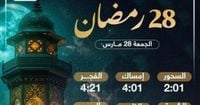As millions of Muslims around the globe eagerly await Eid al-Fitr 2025, the official announcement regarding the first day of Shawwal 1446 is anticipated. This significant date will be determined based on the sighting of the crescent moon of Shawwal after sunset on Saturday, March 29, 2025.
The International Astronomy Center has issued a statement addressing the ongoing debate among astronomers and followers regarding the crescent moon’s visibility, which has sparked widespread discussion on social media. Some groups believe that the crescent moon will be sighted on the evening of March 29, leading to the conclusion that the first day of Shawwal and Eid al-Fitr will fall on Monday, March 31, 2025.
In a notable move, the Australian Fatwa Council has officially announced the date for Eid al-Fitr 2025. According to their statement, the last day of Ramadan will be on Sunday, March 30, 2025, making the first day of Eid al-Fitr Monday, April 1, due to the absence of sighting conditions in Australia.
The Council clarified that after assessing local and international observations, it was determined that the crescent moon of Shawwal will be visible in Sydney on March 29 at 9:57 PM Australian Eastern Time, after sunset. In Perth, the crescent will be sighted at 6:57 PM Australian Western Time, also after sunset. This timing means that the following day cannot be the first of Shawwal.
The method employed by the General Mufti of Australia and the Australian Fatwa Council to determine the end of Ramadan and the first day of Shawwal hinges on the birth of the crescent before sunset and the time of its setting after sunset.
Astronomical calculations indicate that the crescent moon will be born on Saturday, March 29, 2025, shortly after the conjunction occurs at 1:00 PM Cairo time. The crescent will remain visible in the sky over Mecca for seven minutes after sunset, and in Cairo for eleven minutes. This limited visibility raises the likelihood that Sunday, March 30, 2025, will be the first day of Eid al-Fitr from an astronomical perspective.
Badr Al-Amira, a member of the Arab Union for Astronomy and Space Sciences, expressed in statements to Egyptian newspapers that Eid al-Fitr is expected to occur on Monday, March 31, 2025. He noted that it is likely Sunday, March 30, will be the final day of Ramadan, supporting the idea that the first day of Eid will occur on Monday, in accordance with Islamic law which mandates completing Ramadan’s duration of thirty days.
Moreover, a Jordanian study revealed that the age of the crescent moon at sunset will be only four hours and fifty-six minutes, a period too short for the crescent to be visible with the naked eye or through telescopes. This reinforces the expectation that Eid al-Fitr will be announced for Monday.
The International Astronomy Center also confirmed that all calculations indicate the crescent moon of Shawwal will not be visible on March 29, leading to the completion of Ramadan at thirty days and the commencement of Eid al-Fitr on Monday, March 30.
However, the Center's statement noted that since the crescent moon will be born before sunset on March 29 and will set after sunset in the Middle and Western Islamic world, some countries may opt to declare the start of the lunar month the following day, which would be Sunday.
Dr. Abdullah Al-Misnad, a climate professor at Qassim University and deputy president of the Saudi Society for Climate and Meteorology, shared his expectations regarding the end of Ramadan and the arrival of Eid al-Fitr on the platform X. He mentioned, "There is a strong possibility that Ramadan will not complete thirty days." He further elaborated that Ramadan is likely to conclude on the day it began, Saturday, meaning Eid al-Fitr could be celebrated on Sunday, March 30, provided there are no clouds or dust obscuring the crescent's visibility.
As for the date of Eid al-Fitr in Arab and Islamic countries, the National Research Institute of Astronomy in Egypt has stated that the moon will appear approximately eleven minutes after sunset, a duration many international astronomers deem insufficient for the crescent to be seen without the aid of telescopes. Consequently, they lean towards recognizing Eid al-Fitr on Monday, March 31, 2025.
Meanwhile, Taha Rabeh, head of the National Research Institute of Astronomy, affirmed that astronomical calculations have proven to be accurate, with a negligible margin of error due to technological advancements. While some astronomers predict the crescent moon's visibility, the final decision will rest with the relevant authorities in each country after observing the crescent according to Islamic guidelines.
The differences in Eid al-Fitr dates across countries often lead to questions about the recurring debates surrounding this topic. The discrepancies among astronomers regarding the Eid date arise from the variations in official authorities' announcements concerning the commencement of lunar months. It is important to note that the determination of Eid's date falls under the purview of official authorities, not astronomers.
The role of astronomers, as emphasized in a statement from the International Astronomy Center, is to provide scientific information related to the crescent moon's visibility and to assess whether it can be seen. The statement also highlighted that differences sometimes arise between astronomers and jurists, which can create confusion in understanding the proper process for determining the beginning of the lunar month.





